
Postage Stamps of the United States - 1955
Politics
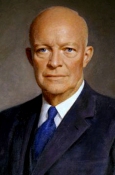
President
Dwight David Eisenhower
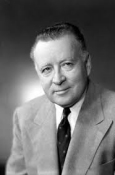
Postmaster General
Arthur E. Summerfield
Music

Click Control Above To Hear
1955 "Rock Around the Clock"
Postage Rates
Domestic Letter Rate: 3¢ per oz.
Postcard Rate: 2¢
Air Mail Rate: 6¢ per oz.
Stamps
Commemorative Postage Stamps of 1955
Rotary Press - Perf 11 x 10½ - 200 Subject Electric Eye Plates

Land Grant Colleges Centennial
East Lansing, MI - Feb. 12, 1955
120,484,800 issued

Rotary International 50th Anniv.
Chicago, IL - Feb. 23, 1955
53,854,750 issued

Armed Forces Reserve Stamp
Washington, D.C. - May 21, 1955
176,075,000 issued

Soo Locks Centenary Stamp
Sault Sainte Marie, MI - June 28, 1955
122,284,600 issued

Atoms for Peace Stamp
Washington, D.C. - July 28, 1955
133,638,850 issued

Fort Ticonderoga Bicentennial Stamp
Fort Ticonderoga, NY - Sep. 18, 1955
118,664,600 issued
Rotary Press - Perf 10½ x 11 - 200 Subject Electric Eye Plates

Pennsylvania Academy of the Arts
Philadelphia, PA - Jan. 15, 1955
Dry Method Printing - 116,139,800 issued

Old Man of the Mountain
Franconia, NH - June 21, 1955
125,944,400 issued

The Andrew Mellon Stamp
Washington, D.C. - Dec. 20, 1955
280 Subject Plates - 112,434,000 issued
Certified Mail Stamp of 1955
Rotary Press - Perf 10½ x 11 - 200 Subject Electric Eye Plates

15¢ Mailman Delivering Letters
Washington, D.C. - June 6, 1955
The Dry Printing Special Handling Postage Stamps of 1955
Wet Vs Dry Printing Methods · Flat Plate - Dry Printing - Perforated 11 - 200 Subject Plates
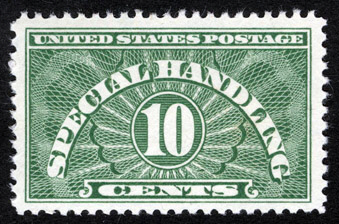
10¢ Special Handling
Dry Printing
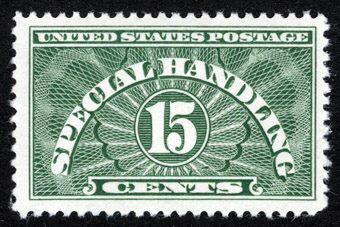
15¢ Special Handling
Dry Printing
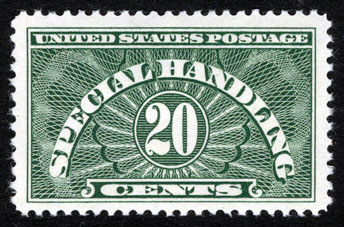
20¢ Special Handling
Dry Printing
The Special Handling stamps were printed using the wet method through most of 1955, when some were printed using the new dry method. It should be noted that all of the Special Handling stamps were printed on flat plate presses and that the 25¢ stamp was never printed using the dry method.
The traditional method of sorting the wet and dry stamps has been to classify as dry-prints those with sharper, crisper printing and a slightly darker green color than the 1928 yellow green. Mr. Bob Rufe, in a series of articles in the 2007 United States Specialist, presents a convincing argument that this is misleading at best, since many of the stamps printed between 1940 and 1955 have just these supposed dry printing characteristics. In fact, he clearly illustrates an example of a wet printing from the 1940-1955 period that is indistinguishable from a dry printing in terms of color and sharpness. This wet stamp would end up in most dealer's dry stock pile. Why does a stamp that looks so much like a dry-printing, turn out to be a wet-print stamp? It turns out these stamps have over-riding characteristics showing they must be wet-prints. These characteristics are:
1. The wet-print, depending on the direction of the grain of the paper, is narrower or shorter than the dry-print, typically from .4 to .7 mm narrower or shorter. This can be seen by overlapping the stamp in question with a known wet-print stamp. A good choiuce for this would be any 25¢ Special Handling stamp since they were all wet-printings. If the stamp in question measures similar in both the vertical and horizontal directions, it must be a wet-print. If the stamp is noticeably longer or wider, then it might be a dry-print.
2. The dry-prints were printed on thicker, stiffer paper. Although it would require an accurate micrometer to make such measurements, many collectors can tell the difference simply by "flicking" the stamp, testing for stiffness.
This new research presents some interesting findings. Since many of the stamps that have been traditionally classified as dry-prints are actually wet-prints, the Special Handling dry-prints appear to be substantially rarer than previously thought. The dry-printings are unknown properly used on a contemporary cover.
The following postage stamp varieties were first issued by the U.S. in 1955
Ordinary issue
see also:The Series of 1954 - "The Liberty Issue"
Number 1030a - ½¢ Benjamin Franklin - Wet Printing - Oct. 20, 1955
Number 1039a - 6¢ Theodore Roosevelt - Wet Printing - Nov. 18, 1955
Number 1049a - 30¢ Robert E. Lee - Wet Printing - Sept. 21, 1955
Number 1050a - 40¢ John Marshall - Wet Printing - Sept. 24, 1955
Number 1051a - 50¢ Susan B. Anthony - Wet Printing - Aug. 25, 1955
Number 1052a - $1 Patrick Henry - Wet Printing - Oct. 7, 1955
Commemoratives
Number 1064 - 3¢ Pennsylvania Academy of the Arts Sesquicentennial - Designer: McCloskey, Jr. - Engraver: C. A. Brooks
Number 1065 - 3¢ Land Grant Colleges Centennial Stamp - Designer: Wm. K. Schrage - Engraver: A. W. Dintaman
Number 1066 - 8¢ Rotary International 50th Anniversary Stamp - Designer: C. R. Chickering - Engraver: R. M. Bower
Number 1067 - 3¢ Armed Forces Reserve Stamp - Designer: C. R. Chickering - Engraver: C. A. Brooks
Number 1068 - 3¢ Old Man of the Mountain Sesquicentennial - Designer: Wm. K. Schrage - Engraver: R. M. Bower
Number 1069 - 3¢ Soo Locks Centenary Stamp - Designer: C. R. Chickering - Engraver: C. A. Brooks
Number 1070 - 3¢ Atoms for Peace Stamp - Designer: George R. Cox - Engraver: R. M. Bower
Number 1071 - 3¢ Fort Ticonderoga Bicentennial Stamp - Designer: Enrico Arno - Engraver: C. A. Brooks
Number 1072 - 3¢ Andrew Mellon Stamp - Designer: V. S. McCloskey, Jr. - Engraver: R. M. Bower
Air Mail
There were no new Air Mail stamps issued in 1955.
Special Delivery
There were no new Special Delivery stamps issued in 1955.
Certified Mail
Number FA1 - 15¢ Mailman Delivering Letters
Special Handling - Dry Printing - Wet Vs Dry
Number QE1a - 10¢ Special Handling Stamp
Number QE2a - 15¢ Special Handling Stamp
Number QE3a - 20¢ Special Handling Stamp





